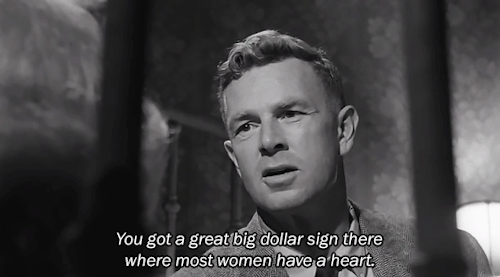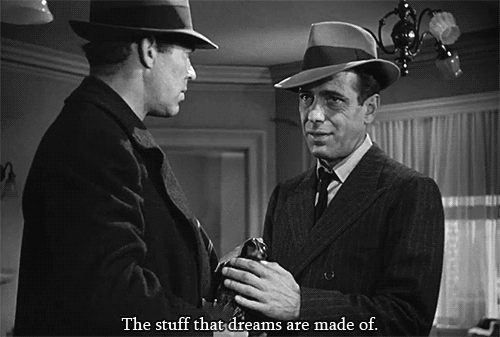What better to watch on a cold autumn evening than a gritty old film noir? I’ve been postponing writing this but with today’s uncannily dark weather, I finally felt inspired to start writing. And I suppose that’s not an accident, considering the subjects noir films deal with and the way it is shot. After writing about movies that unfailingly cheer me up, I wanted to also share my favorite moody films. In a nutshell, film noir is a term used for a subgenre of crime dramas that were popular throughout the 1940s and the 1950s. These movies candidly and unreservedly portrayed the brutal reality of criminal life, with the help of exceptional cinematography.

Like every subgenre, film noir is often seen as a genre full of clichés. The conventional characters are women portrayed as the femme fataleFemme fatale is a stock character of a mysterious and seductive woman whose charms ensnare her lovers, often leading them into compromising, dangerous, and deadly situations. ., followed by a strong-minded private detective. Or a non-detective protagonist but eventually they’ll both fall for her cunning charms. And of course, there’s always a crime and/or mystery at the heart of the film. But film noir was and is so much more than that. Sure, this might be the “formula” for most film noir movies but every director had a different vision of the film which made them all unique.

These movies are filled with such iconic and unforgettable quotes and shots that I still remember the first time I saw any of them. The thing is, I remember the first time I saw any old movie because it wasn’t easy to find them. I recall getting up early on Saturday mornings for the sole reason of catching whatever classic that one channel was screening. And that was in high school when all I wanted to do was sleep in after five days of school. So let’s start this list off!

Double Indemnity (1944)
Double Indemnity was made at the height of film noir’s popularity yet it is considered the epitome of its genre. It’s possibly the most daring film noir considering its bleak realism and unapologetic rotten characters, as they call themselves. Fred MacMurray plays an insurance man who gets involved with an unscrupulous woman played by Barbara Stanwyck. She talks him into taking out a life policy on her husband’s name and getting away with his murder and the insurance money. And now it’s all about laying low and getting away with it all, right? Double Indemnity handles the plot resolution marvelously, and the quality of the movie never falters.
Walter Neff: “…it came over me that everything would go wrong. It sounds crazy Keyes, but it’s true, so help me, I couldn’t hear my own footsteps. It was the walk of a dead man.”

The Maltese Falcon (1941)
The Maltese Falcon is, in fact, the first film noir I ever saw, on one of those Saturday mornings I mentioned. This was also the first classic I ever recommended to Grégory back when we met. He saw it the following day and enjoyed it, which impressed me because people rarely follow through on classic film recommendations. Anyhow, on to the film, it’s an adaptation of Dashiell Hammett’s novel of the same name and it pretty much represents the genre. Humphrey Bogart plays a hard-boiled detective hired by Mary Astor to track down her sister but what he gets instead is an intriguing murder mystery, lies and a secret bird statue everyone’s after. This movie might be the most impressive director’s debut ever. It’s hard to believe this is John Huston’s first feature film because it is flawless!
Kasper Gutman: “I couldn’t be fonder of you if you were my own son. But, well, if you lose a son, it’s possible to get another. There’s only one Maltese Falcon.”

Laura (1944)
The movie Laura starts after the murder already happened. Dana Andrews portrays the detective investigating the murder of a beautiful woman called Laura and played by Gene Tierney. The more he finds out about Laura, the more he falls in love with a dead woman. But this movie is far from simple and there are plenty of convoluted twists and surprises ahead so I’ll let you discover those for yourself!
Waldo Lydecker: “My dear, either you were born on an extremely rustic community, where good manners are unknown, or you suffer from a common feminine delusion that the mere fact of being a woman exempts you from the rules of civilized conduct.”

The Third Man (1949)
Nobody does a better play of light and shadows than The Third Man starring Orson Welles and Joseph Cotten. Set in war-torn Vienna with most scenes shot at night, Welles’ notorious character Harry Lime hides away in the shadows of buildings. Honestly, the movie is a masterpiece. Vienna’s cobbled streets never looked more beautiful than when veiled in these dramatic noir shadows. Each and every aspect of this film is perfectly on point. I’ve seen it countless times yet it never gets old. In fact, I’m planning on seeing it at the cinema soon. I love revisiting my favorite classics on the big screen because nothing transports you into the film world better than the big screen.
Harry Lime: “Like the fella says, in Italy for 30 years under the Borgias they had warfare, terror, murder, and bloodshed, but they produced Michelangelo, Leonardo da Vinci, and the Renaissance. In Switzerland they had brotherly love – they had 500 years of democracy and peace, and what did that produce? The cuckoo clock.”

Sunset Boulevard (1950)
William Holden plays a down-on-his-luck screenwriter who accidentally meets a fading silent film star played by Gloria Swanson. What at first seems like a great opportunity for a new screenplay takes a turn for worse when he realizes he’s dealing with a delusional recluse. Completely isolated and sheltered from the world, she still believes she’ll make a comeback to the movie screen. Over time, this evolves into an odd love story that doesn’t get a happy ending. The second film on this list by Billy Wilder, Sunset Boulevard is a film about movies, honest and brutal, devoid of on-screen magic.
Joe Gillis: “You don’t yell at a sleepwalker – he may fall and break his neck. That’s it: she was still sleepwalking along the giddy heights of a lost career.”

Honorable mentions
Touch of Evil (1958)
In a Lonely Place (1950)
Mildred Pierce (1945)
Gilda (1946)
They Live by Night (1948)
Brigita Soldo
Travel Photographer · Creative Content Creator · Vintage & Sustainable Fashion Advocate




